14 Health Benefits of Matsyasana and How to Do It?
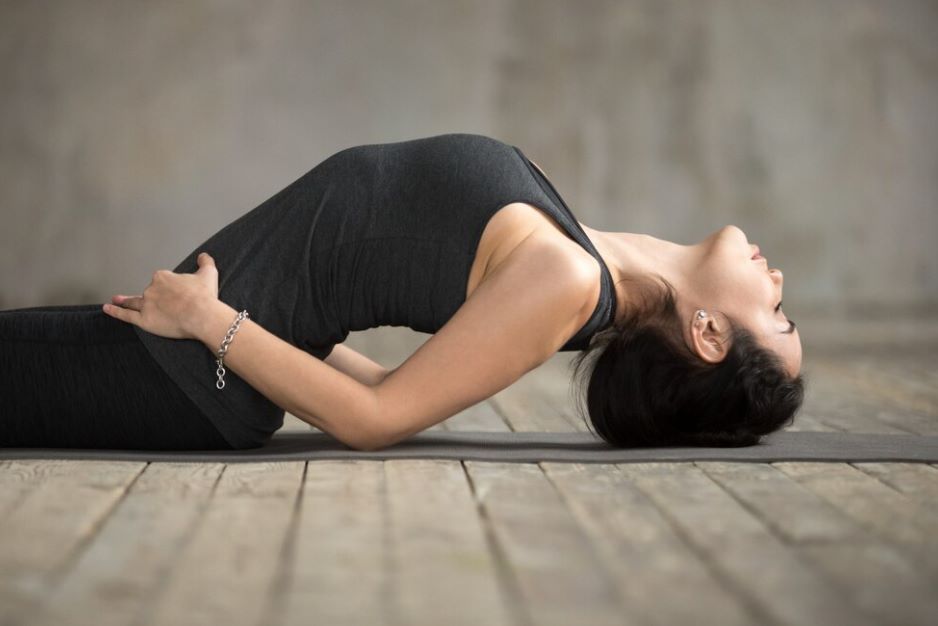
According to ancient Yogic texts, Matsyasana can restore spinal strength and overall balance and improve mobility. It requires lying with a back arch, which helps relieve back and spinal pain. It can also be the perfect yoga asana for meditation and mental well-being.
It is essential to know the correct method of performing a yoga pose before performing it. Each pose has its own benefits and challenges, so knowing what works best is necessary.

Table of Contents

-
What is Matsyasana?
-
Steps for Performing Matsyasana
-
Health Benefits of Matsyasana
-
Mudras of Matsyasana
-
Types of Matsyasana
-
Things to Know Before Doing Matsyasana
-
How Long to Sit in Matsyasana?
-
Risks of Overdoing Matsyasana
-
Tips for Practising Matsyasana
-
Precautions and Contraindications
-
Who Should Avoid?
-
Easy Modifications of Matsyasana
-
Frequently Asked Questions
What is Matsyasana?
Matsyasana, or the fish pose, is mainly known for increasing flexibility and muscle strength. Matsya means fish since this position resembles a fish. Apart from its multiple health benefits, this yoga position is also popular for creating harmony between mind, body, and soul.
In today's world, being self-aware and having a calm mind is essential. Matsyasana yoga can help improve feelings of overwhelm and cure many physical ailments. Practising Matsyasana ensures your well-being and keeps you energetic. One such yoga asana can be perfect for stretching your muscles and relieving pain and discomfort.
How to Perform Matsyasana (Fish Pose)?

Now that you know the advantages of Matsyasana, you must be curious to see how it can be performed. Here are the steps to help you out:
Step 1: Start with the Savasana (Corpse Pose). It requires you to lie down on your back with your feet and legs apart.
Step 2: Bring your legs and hands together. Stretch your body completely, and make sure that the toes are pointed.
Step 3: Start lifting your body while keeping your hands under the torso. Then, rest your weight on the floor with your elbows.
Step 4: Keep your head and slightly lift your back to form an arch. Hold this position while inhaling and exhaling deeply.
Step 5: While holding your feet with the palms, rotate your wrists to release tension from these muscles. Relax your body and mind, and retract to the original position after 30 seconds.
14 Health Benefits of Matsyasana
There are multiple health benefits of Matsyasana yoga, which has increased its popularity recently. Here are some of the significant benefits of this yoga asana:
1. Enhances Breathing
Practising the Matsyasana can help improve the function of your respiratory system. You can take long, deep breaths in this pose, enhancing your lung capacity. This position is, therefore, effective for treating respiratory disorders like asthma and bronchitis. You can consequently ensure better breathing and protect yourself from breathing troubles with this asana.
2. Improves Posture
Proper posture can be essential to avoid slouching and maintain mobility for a long time. Matsyasana allows you to stay in a position for a long time, where you get to arch your back and stimulate blood flow across your body. It expands the chest and stretches the spine, contributing to improving your overall posture. In addition, it prevents your body from hunching forward and, in turn, improves mobility.
3. Strengthens Neck, Abs & Thighs
Pain in the neck and shoulders is familiar with excessive workload. Your neck muscles become more assertive while stretching your back and lying down in Matsyasana. In addition, the muscles in your abs and thighs improve with better blood circulation. Further, this yoga asana will help you maintain the proper shape and avoid pain in these areas.
4. Relieves Stress
Yoga asana, like Matsyasana, can be effective for both physical and mental well-being. It requires you to lay in a specific position while breathing deeply. This helps you to collect your thoughts and reflect upon your activities, taking a positive outlook. In addition, it can be effective for controlling anxiety and calming the nerves. This way, you can control the feelings of fear, anxiety and tension, maintaining mental well-being.
5. Reduces Abdominal Fat
Excessive fat accumulation in the abdominal areas is a common issue. If you do not prefer weight training, Matsyasana can be the perfect way to get rid of this fat. Its leg-raised variation requires you to lift your leg upward with a perfectly arched back. This position can effectively burn the fat from your abdominal areas and help you maintain a better shape.
6. Stimulates the Endocrine Glands
Hormones are a significant requirement for the proper functioning of the organs. The endocrine gland is essential since it helps produce hormones and ensure they travel to all body parts, from blood to veins. With Matsyasana, you can maintain and stimulate this gland. Additionally, you can stimulate the pituitary and pineal glands with this asana while increasing brain blood flow. As a result, it maintains the proper functioning of the body parts.
7. Improves Digestion
Indigestion has become a liability with unhealthy eating routines and can cause various abdominal issues. Matsyasana is effective for stretching the abdominal and core muscles. It gently massages the internal organs within the abdomen, thereby improving its digestion abilities. This way, it controls digestive issues like constipation, diarrhoea, nausea and bloating.
8. Helps with Metabolism
Metabolism is important for managing a healthy weight. Cravings for fast food can take a toll on your shape. Here, Matsyasana can come to your rescue. As it stimulates your abdomen and massages the muscles, it can increase your metabolism. As a result, your weight remains healthy and balanced with better digestion. This way, you can avoid gaining excessive weight.
9. Tones the Thigh and Glutes Muscles
Most people want toned legs and thighs. However, rigorous workout routines can be challenging. Matsyasana is a simple yoga pose that can work wonders in this context. As it holds the legs strictly, the thigh muscles open up and receive blood circulation. Moreover, it also tones the muscles in your glutes, hamstrings, groin, and psoas. This way, you maintain proper body proportions.
10. Manages Menstrual Pain
Pain and discomfort during the menstrual cycle can disrupt work and daily life. Here, you can practise Matsyasana to reduce these issues. As this poses massages and stimulates the abdominal muscles, it can control the menstrual flow. This way, it helps to manage the usual pain and discomfort during this period.
11. Relieves Mild Depression
Matsyasana is believed to stimulate the release of endorphins, neurotransmitters that promote well-being and happiness. Practising this pose regularly may help alleviate symptoms of mild depression and uplift the mood. Like any yoga practice, Matsyasana can help increase energy levels and lift one's mood.
12. Stimulates the Parasympathetic Nervous System
Matsyasana activates the parasympathetic nervous system, which induces relaxation and calmness. This can help reduce stress, anxiety, and fatigue. A relaxed nervous system makes it easy for people to deal with difficulties. With the daily practice of Matsyasana, the nervous system remains calm.
13. Alleviates Respiratory Issues
By opening up the chest and lungs, Matsyasana can improve respiratory function and alleviate symptoms of asthma and bronchitis. The deep breathing encouraged in this pose also helps clear the respiratory passages. It also helps increase lung capacity and keeps the lungs healthy and free from breathing disorders.
14. Relieves Tension in the Shoulders and Upper Back
Matsyasana's backward bend stretches and releases shoulder and upper back tension. This can help alleviate stiffness and discomfort caused by prolonged sitting or computer work periods. This pose strengthens the upper back muscles, including the rhomboids and trapezius. This can improve posture and reduce the risk of developing chronic back pain.
The Mudras of Matsyasana (Fish Pose)
Enhance the effectiveness of the Matsyasana pose by adding some mudras. Incorporating these mudras will help promote positive energy flow in the body. Here are the mudras commonly incorporated into Matsyasana (fish pose) and how to use each one:
1. Gyan Mudra (Gesture of Knowledge)
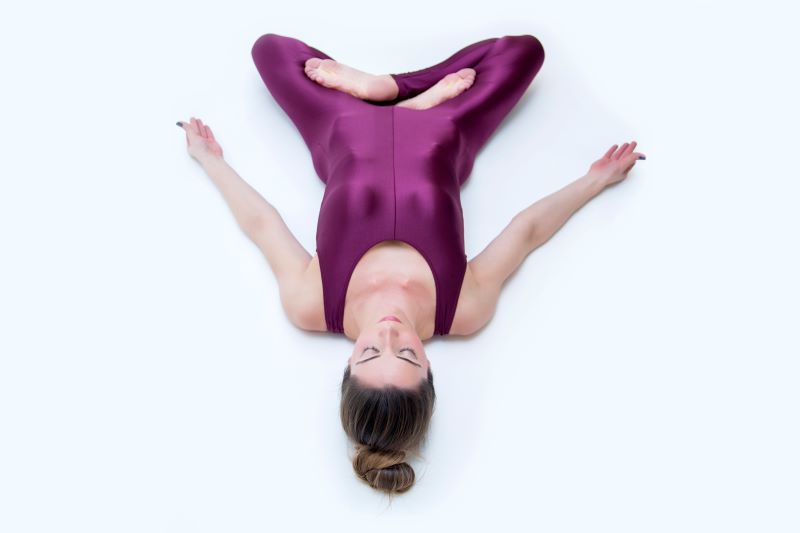
Touch the tip of the index finger to the tip of the thumb while keeping the other three fingers extended. In Matsyasana, maintain the Gyan Mudra to enhance concentration and stimulate the flow of knowledge and wisdom.
Benefits of Gyan Mudra: It helps to calm the mind and deepen the meditative aspect of the Matsyasana posture.
2. Anjali Mudra
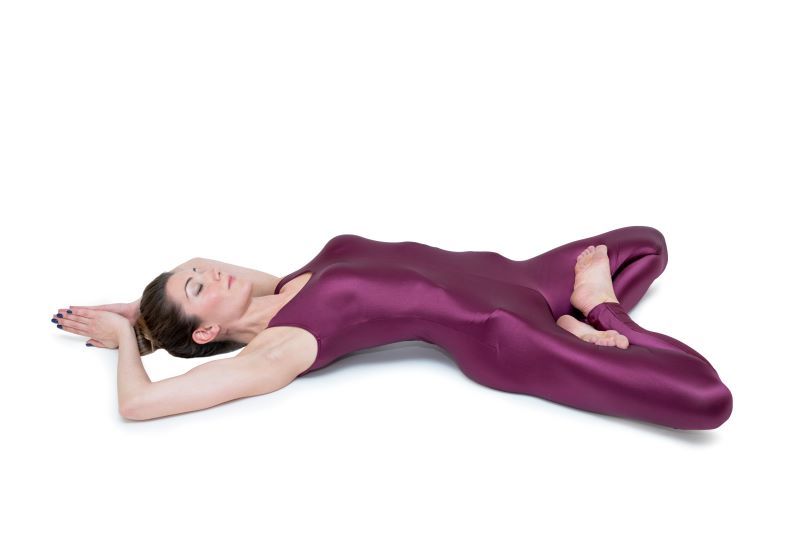
In Matsyasana, keep your arms alongside your body. Lift your chest and gently slide your hands at your heart centre, palms touching. Fingers point upwards, and thumbs rest lightly on your chest. Or else you can also join your hands, stretching them outwards parallel to your head.
Benefits of Anjali Mudra: Anjali Mudra in Matsyasana deepens the backbend by gently opening the chest. It also promotes a sense of calmness and inward focus, enhancing the meditative quality of the pose.
3. Apana Mudra (Gesture of Digestion)
Join the tips of the middle and ring fingers to the tips of the thumbs. Keep the index and little fingers extended. Apana Mudra activates the Apana Vayu, the downward-flowing energy responsible for elimination and digestion.
Benefits of Apana Mudra: Incorporating this mudra in Matsyasana can help enhance the detoxification process, promoting better digestion and elimination of toxins from the body.
4. Shunya Mudra (Gesture of Emptiness)
Bend the middle finger and place the thumb over it. Keep the other fingers extended. Shunya Mudra is believed to help alleviate ear-related problems and improve the functioning of the throat chakra.
Benefits of Shunya Mudra: Incorporating this mudra in Matsyasana can enhance the pose's benefits for the throat and neck region, promoting better communication and expression.
Incorporating these mudras into Matsyasana can deepen the pose's physical, mental, and spiritual benefits, enhancing overall well-being and inner harmony.
Types of Matsyasana
There are various types of Matsyasana (Fish Pose), each offering unique variations and benefits. Here are some common types:
1. Supta Matsyasana (Reclining Fish Pose)
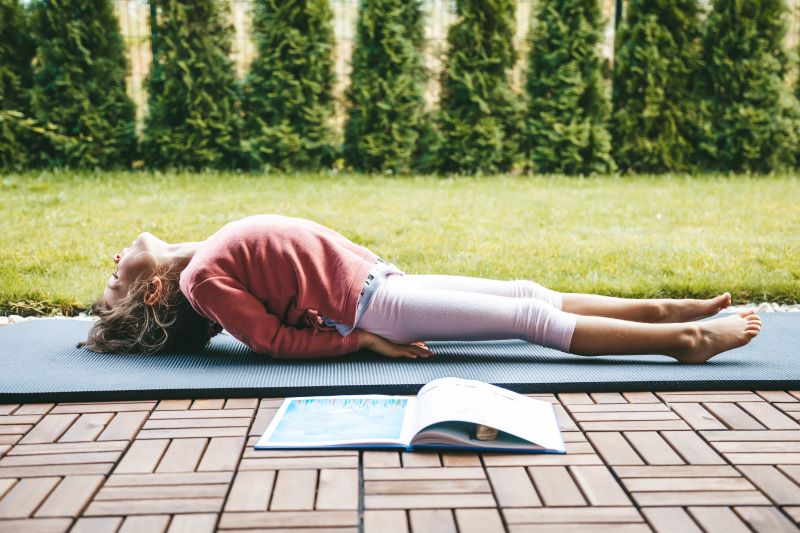
Lie on your back with your legs extended and your arms resting alongside your body. Lift your chest towards the sky by arching your back and supporting the weight with your forearms and elbows. This variation provides a gentle stretch to the chest, throat, and abdomen while also relieving tension in the lower back.
2. Padma Matsyasana (Lotus Fish Pose)
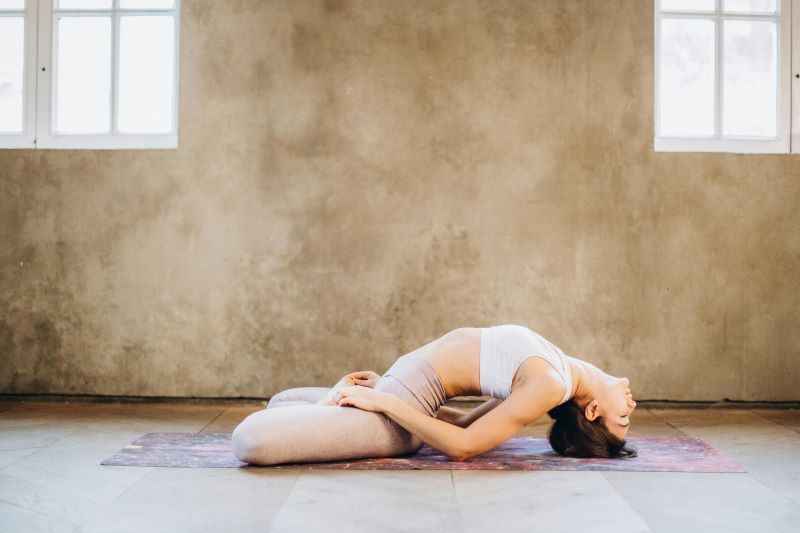
In Padma Matsyasana, you should begin in Padmasana (Lotus Pose) and then recline backwards into Matsyasana. This variation combines the benefits of both poses, opening up the chest, shoulders, and hips while stimulating the abdominal organs.
3. Bolster Matsyasana (Bolster Fish Pose)
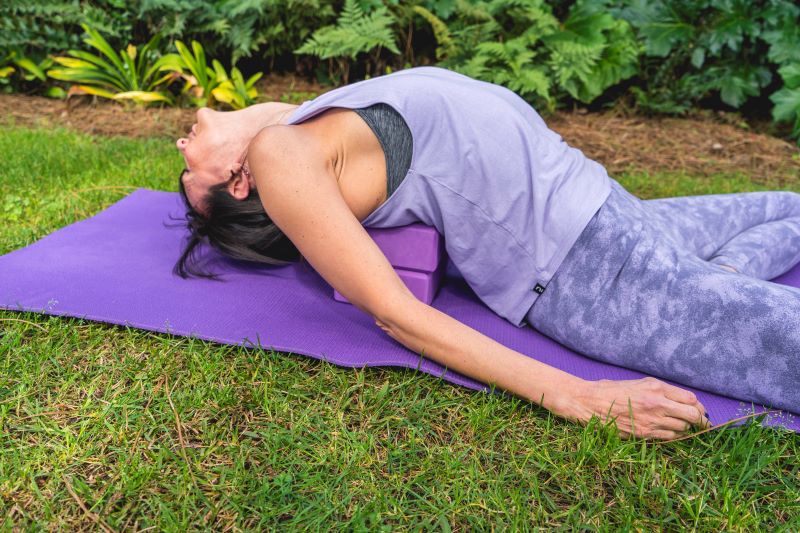
This restorative yoga pose starts in the normal Matsyasana pose but uses a bolster as a support. Place the bolster below the upper back and let your head hang loose and touch the floor. Place your legs according to your comfort level. This pose opens the chest and upper abdomen. The hands will remain relaxed beside the body or stretched away from the body.
Things to Know Before Doing Matsyasana Yoga
There are several essential points to consider before starting the Matsyasana to avoid risks and mishaps. Pay attention to the needs of your body before doing this yoga. Here are some things to know before doing Matsyasana (Fish Pose) yoga:
- Warm-Up: Before attempting Matsyasana, it's essential to warm up your body, especially your neck, shoulders, and spine, with gentle stretches and movements. This prepares your body for the pose and reduces the risk of injury.
- Proper Alignment: Focus on maintaining proper alignment throughout the pose. Keep your legs engaged and feet together, with your toes pointed. Your arms should rest comfortably beside your body, palms facing down.
- Neck Safety: Be mindful of your neck during Matsyasana. Avoid putting excessive pressure on your cervical spine by gently supporting the weight of your head with your elbows and forearms. Never force your neck into an uncomfortable position.
- Breathing: Pay attention to your breath while in Matsyasana. Take deep, slow breaths to help you relax into the pose and maintain stability. Avoid holding your breath, as it can increase tension in your body.
- Counter Poses: After practising Matsyasana, incorporate counter poses to release tension and restore body balance. Gentle stretches like Child's Pose or a seated forward bend can help counteract the backbend of Matsyasana.
- Consultation: If you have any existing medical conditions or injuries, consult a professional or a qualified yoga instructor before attempting Matsyasana. They can provide guidance and modifications to ensure your safety and well-being.
- Listen to Your Body: Pay attention to how your body feels during Matsyasana. If you experience pain or discomfort, gently leave the pose and reassess your alignment. Honouring your body's limitations is essential.
How Long to be in Matsyasana?
Understanding your body’s limits is essential to this yoga. Your expertise and comfort level must decide how long to hold the pose. Here's how long practitioners at different levels can sit in Matsyasana:
- Beginners: Start slowly and gradually increase the pose duration as you build strength and flexibility. Initially, beginners can aim to hold Matsyasana for about 15 to 30 seconds. Focus on maintaining proper alignment and breathing deeply.
- Intermediate Level: Intermediate practitioners can hold Matsyasana longer, typically aiming for 30 to 60 seconds. With increased flexibility and strength, intermediate-level practitioners can deepen their Matsyasana pose.
- Advanced Level: Advanced practitioners with significant strength, flexibility, and body awareness can hold Matsyasana for longer durations, up to 1 to 2 minutes or even longer.
Regardless of your level, it's crucial to approach Matsyasana with patience, mindfulness, and respect for your body's capabilities.
Risks of Overdoing Matsyasana
Doing too much of anything has adverse effects. Practising Matsyasana in moderation while listening to your body’s needs is necessary. Here are the risks of overdoing the Matsyasana exercise:
- Strain on the Neck: Overdoing Matsyasana can significantly lead to strain on the neck if you forcefully push your head back or hold the pose for an extended period without proper support. Excessive pressure on the cervical spine can cause discomfort, stiffness, or even injury to the neck muscles and vertebrae.
- Compression of the Spine: Holding Matsyasana for too long or with excessive force can compress the spine, particularly in the cervical and thoracic regions. This compression can result in discomfort, pain, or worsening of existing spinal issues such as herniated discs or degenerative disc disease.
- Strain on the Lower Back: While Matsyasana is primarily a backbend, overdoing the pose can strain the lower back muscles, especially if proper alignment is not maintained. Hyperextending the lumbar spine or forcing the backbend beyond your current level of flexibility can lead to muscle strain or even lumbar disc issues.
- Increased Pressure on the Heart and Lungs: Lifting the chest increases pressure on the heart and lungs, particularly when holding the pose for an extended period or in advanced variations. More than doing the pose with adequate preparation and breath awareness leads to shortness of breath or cardiovascular strain.
- Risk of Injury: Overzealous practice of Matsyasana without proper guidance, warm-up, or respect for individual limitations can increase the risk of injury. Common injuries associated with overdoing Matsyasana include strains, sprains, and overuse injuries to the neck, shoulders, back, and chest muscles.
To mitigate these risks, practise Matsyasana mindfully, listen to your body's signals, and consult a qualified yoga instructor for proper guidance and modifications. Focus on gradual progress, correct alignment, and breath awareness to ensure a safe and beneficial practice.
What are the Tips for Practising Matsyasana?
Matsyasana has several health benefits. However, achieving this pose can be challenging for beginners. The following tips can be beneficial for them while attempting this asana:
It will be better to start by lying supine. Then, you can begin folding your legs as in Sukhasana, Ardha Padmasana or Padmasana.
If you feel discomfort in the neck or throat, you can lower the chest slightly toward the floor.
If arching seems difficult or painful, you can place thick clothing or blankets to support your back and spine.
To prevent pain and injury, it is advisable to avoid putting excessive pressure on the back. If you feel pain, retract to the original position immediately.
Practise this asana early in the morning on an empty stomach else it can cause nausea.
You can intensify this pose by bringing your arms up toward the ceiling with your palms touching each other.
What are the Precautions and Contraindications of Matsyasana?
Even though Matsyasana helps people have a healthy life, there can be certain precautions and contradictions that one should consider. Here are some precautions associated with this asana:
- It is advisable to avoid this yoga asana if you are suffering from high or low blood pressure and insomnia issues.
- If you are a beginner, do not perform this yoga asana without the presence of a yoga professional.
- People with knee injuries should also avoid this asana. It pressurises these muscles, which can be painful.
- While lifting the upper body, root into your forearms, heels and engaged thighs. Otherwise, your head will not find enough support and might cause a neck injury.
- Avoid overstretching your body or straining your neck. These can cause serious pain and injuries.
- If you recently had a hernia or abdominal surgery, you can skip this yoga asana.
Above all, the one precaution that must be considered by people having any pre-existing disease, such as heart disease, spinal issues, or recent surgeries. Matsyasana must be performed only when doctors recommend it in such cases. However, you must undergo treatment and surgeries or such a critical condition. Hence, it is best to have a health insurance plan for you with extensive coverage to cover the cost of such treatment.
Who Should Avoid Matsyasana?
Matsyasana's benefits are numerous. However, it can yield opposite results for people with the following issues.
- Individuals with Neck Injuries: Matsyasana involves a deep backward bend of the neck, which can increase existing neck injuries or conditions like cervical spondylosis, herniated discs, or neck muscle strain. People with such injuries should avoid this pose.
- Recent Surgery Recipients: Individuals who have undergone recent surgery, particularly on the neck, spine, or chest area, should avoid Matsyasana until they have fully recovered and received clearance from their healthcare provider.
- People Having High Blood Pressure and Heart Conditions: Matsyasana involves a backward bend that increases pressure on the heart and lungs. Individuals with uncontrolled high blood pressure, heart conditions, or cardiovascular issues should avoid this pose.
- Pregnant Women: Women should avoid deep backward bends like Matsyasana. These poses can compress the abdomen, restrict blood flow to the uterus, and potentially endanger the health of the mother and the foetus.
- Those With Glaucoma and Eye Conditions: Matsyasana involves tilting the head back, which can increase intraocular pressure. Individuals with glaucoma or other eye conditions characterised by increased eye pressure should avoid this pose to prevent their condition from worsening.
- People With Severe Asthma or Respiratory Issues: Matsyasana may compress the chest and restrict breathing, increasing symptoms in individuals with severe asthma or respiratory conditions. Those with such conditions should avoid this pose.
- People Having Osteoporosis or Osteopenia: Individuals with osteoporosis or osteopenia, conditions characterised by decreased bone density, should avoid deep backward bends. These poses can increase the risk of fractures or spinal compression fractures.
- People with Hernia or Digestive Disorders: Individuals with hernias or digestive disorders, such as hiatal hernia, inguinal hernia, or severe acid reflux, should avoid Matsyasana because the pose increases pressure on the affected area, leading to discomfort or complications.
What are the Easy Modifications of Matsyasana?
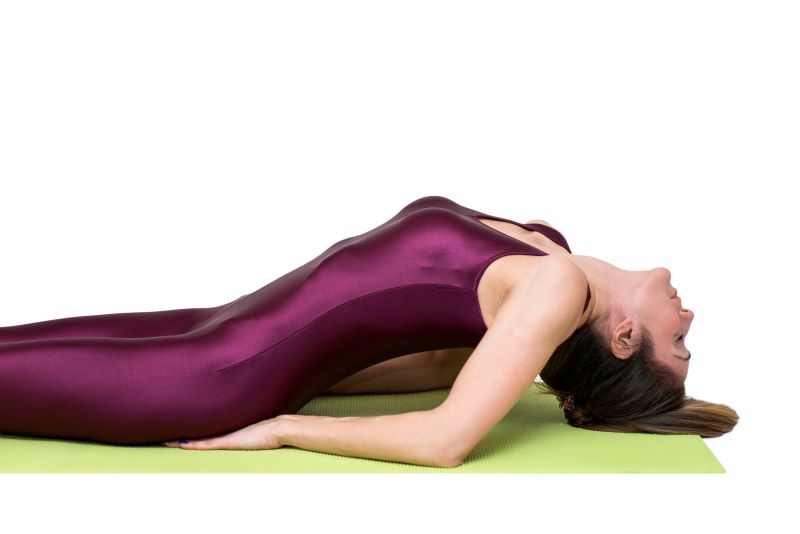
Some modifications of Matsyasana can be easy for beginners who find it difficult to perform. Here are some that you can practise.
If the crown has difficulty coming up while arching the back, you can place a blanket or block under your head.
Hanging the head can also make you feel better in this position.
Placing a rolled blanket under the back can greatly support performing this yoga asana.
Stretching the legs forward will be easier than keeping them folded in Padmasana. It can be effective in the beginning.
If you feel pain in your back and spine, you can support your elbows while lifting your upper body.
Hopefully, you will have a better idea of the health benefits of Matsyasana.
As understandable, Matsyasana’s benefits are numerous regarding physical and mental health. Laying with the back straight is the preferred position for completing this basic yoga pose. To prevent complications, it is recommended that beginners begin with the basic warm-ups. Through Matsyasana, you can get a stronger back and spine with practice.














